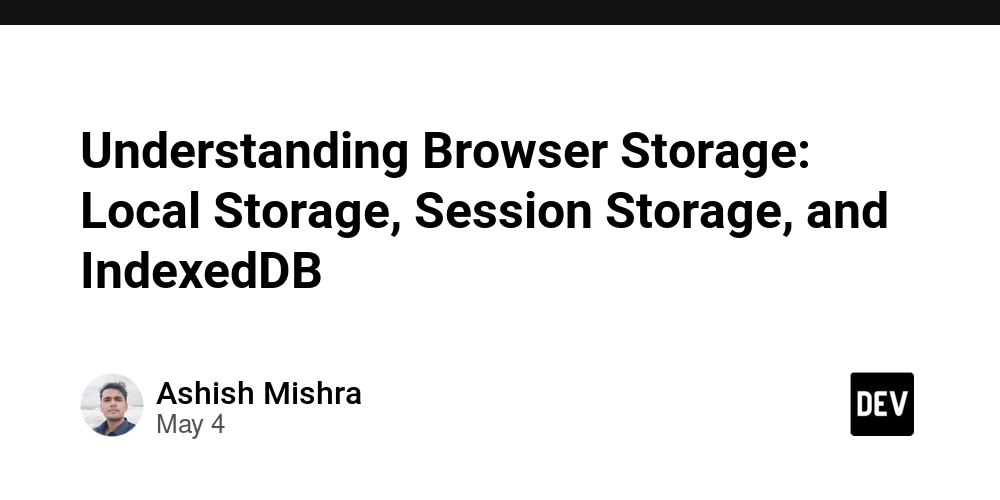Understanding Browser Storage: Local Storage, Session Storage, and IndexedDB
In modern web development, efficiently managing data on the client-side is crucial for creating seamless user experiences. Browsers offer several storage mechanisms to retain data—each with distinct use cases, capabilities, and limitations. In this post, we'll explore the three primary browser storage options: Local Storage, Session Storage, and IndexedDB, and when to use each. 1. Local Storage Local Storage is part of the Web Storage API, introduced in HTML5, and provides a simple key-value store accessible via JavaScript Key Characteristics: Persistence: Data persists even after the browser is closed and reopened. Capacity: Around 5MB per origin (varies by browser). Data Format: Stores only strings. Synchronous API: Operations block the main thread. Use Cases: Saving user preferences (e.g., theme selection). Storing simple cached data. Keeping track of user activity without server interaction. Example: localStorage.setItem('theme', 'dark'); const theme = localStorage.getItem('theme'); Limitations: No support for complex data structures (need to JSON.stringify()). Not secure—data is stored in plain text. Synchronous, which can affect performance for larger operations. 2. Session Storage Session Storage is also part of the Web Storage API and works similarly to Local Storage but with a shorter lifespan. Key Characteristics: Persistence: Data is available only for the duration of the page session (until the tab or window is closed). Capacity: Similar to Local Storage (~5MB). Data Format: Stores only strings. Synchronous API. Use Cases: Preserving state across a single tab session (e.g., form data, temporary selections). Storing sensitive data that shouldn't persist beyond the session. Example: sessionStorage.setItem('formStep', '2'); const step = sessionStorage.getItem('formStep'); Limitations: Not shared across tabs or windows. Still lacks support for non-string data and large-scale storage needs. 3. IndexedDB IndexedDB is a low-level API for storing large amounts of structured data, including files and blobs. Key Characteristics: Persistence: Data persists until explicitly deleted. Capacity: Much larger than Local/Session Storage (hundreds of MBs or more). Data Format: Supports complex data types (objects, blobs, etc.). Asynchronous API: Non-blocking, promise-based access. Indexed: Supports advanced querying and indexing. Use Cases: Offline-first applications. Caching large datasets. Storing files, blobs, or complex user-generated content. Example: const request = indexedDB.open('MyDatabase', 1); request.onupgradeneeded = (event) => { const db = event.target.result; db.createObjectStore('users', { keyPath: 'id' }); }; request.onsuccess = (event) => { const db = event.target.result; const transaction = db.transaction(['users'], 'readwrite'); const store = transaction.objectStore('users'); store.add({ id: 1, name: 'Alice' }); }; Limitations: More complex API. IndexedDB transactions and error handling require careful implementation. Choosing the Right Storage Use Case Recommended Storage Small, persistent settings Local Storage Temporary, per-tab data Session Storage Large, complex datasets IndexedDB Offline data storage IndexedDB Conclusion Understanding the strengths and limitations of each browser storage method helps you design more efficient, responsive, and scalable front-end applications. Use Local Storage and Session Storage for simple key-value needs, and switch to IndexedDB for advanced, large-scale data handling.

In modern web development, efficiently managing data on the client-side is crucial for creating seamless user experiences. Browsers offer several storage mechanisms to retain data—each with distinct use cases, capabilities, and limitations. In this post, we'll explore the three primary browser storage options: Local Storage, Session Storage, and IndexedDB, and when to use each.
1. Local Storage
Local Storage is part of the Web Storage API, introduced in HTML5, and provides a simple key-value store accessible via JavaScript
Key Characteristics:
Persistence: Data persists even after the browser is closed and reopened.
Capacity: Around 5MB per origin (varies by browser).
Data Format: Stores only strings.
Synchronous API: Operations block the main thread.
Use Cases:
Saving user preferences (e.g., theme selection).
Storing simple cached data.
Keeping track of user activity without server interaction.
Example:
localStorage.setItem('theme', 'dark');
const theme = localStorage.getItem('theme');
Limitations:
No support for complex data structures (need to JSON.stringify()).
Not secure—data is stored in plain text.
Synchronous, which can affect performance for larger operations.
2. Session Storage
Session Storage is also part of the Web Storage API and works similarly to Local Storage but with a shorter lifespan.
Key Characteristics:
Persistence: Data is available only for the duration of the page session (until the tab or window is closed).
Capacity: Similar to Local Storage (~5MB).
Data Format: Stores only strings.
Synchronous API.
Use Cases:
Preserving state across a single tab session (e.g., form data, temporary selections).
Storing sensitive data that shouldn't persist beyond the session.
Example:
sessionStorage.setItem('formStep', '2');
const step = sessionStorage.getItem('formStep');
Limitations:
Not shared across tabs or windows.
Still lacks support for non-string data and large-scale storage needs.
3. IndexedDB
IndexedDB is a low-level API for storing large amounts of structured data, including files and blobs.
Key Characteristics:
Persistence: Data persists until explicitly deleted.
Capacity: Much larger than Local/Session Storage (hundreds of MBs or more).
Data Format: Supports complex data types (objects, blobs, etc.).
Asynchronous API: Non-blocking, promise-based access.
Indexed: Supports advanced querying and indexing.
Use Cases:
Offline-first applications.
Caching large datasets.
Storing files, blobs, or complex user-generated content.
Example:
const request = indexedDB.open('MyDatabase', 1);
request.onupgradeneeded = (event) => {
const db = event.target.result;
db.createObjectStore('users', { keyPath: 'id' });
};
request.onsuccess = (event) => {
const db = event.target.result;
const transaction = db.transaction(['users'], 'readwrite');
const store = transaction.objectStore('users');
store.add({ id: 1, name: 'Alice' });
};
Limitations:
More complex API.
IndexedDB transactions and error handling require careful implementation.
Choosing the Right Storage
| Use Case | Recommended Storage |
|---|---|
| Small, persistent settings | Local Storage |
| Temporary, per-tab data | Session Storage |
| Large, complex datasets | IndexedDB |
| Offline data storage | IndexedDB |
Conclusion
Understanding the strengths and limitations of each browser storage method helps you design more efficient, responsive, and scalable front-end applications. Use Local Storage and Session Storage for simple key-value needs, and switch to IndexedDB for advanced, large-scale data handling.





































































































































































![[The AI Show Episode 145]: OpenAI Releases o3 and o4-mini, AI Is Causing “Quiet Layoffs,” Executive Order on Youth AI Education & GPT-4o’s Controversial Update](https://www.marketingaiinstitute.com/hubfs/ep%20145%20cover.png)




























































































































![[DEALS] Microsoft 365: 1-Year Subscription (Family/Up to 6 Users) (23% off) & Other Deals Up To 98% Off – Offers End Soon!](https://www.javacodegeeks.com/wp-content/uploads/2012/12/jcg-logo.jpg)




![From Art School Drop-out to Microsoft Engineer with Shashi Lo [Podcast #170]](https://cdn.hashnode.com/res/hashnode/image/upload/v1746203291209/439bf16b-c820-4fe8-b69e-94d80533b2df.png?#)




















![Re-designing a Git/development workflow with best practices [closed]](https://i.postimg.cc/tRvBYcrt/branching-example.jpg)




















































































(1).jpg?#)






























_Inge_Johnsson-Alamy.jpg?width=1280&auto=webp&quality=80&disable=upscale#)































































































![The Material 3 Expressive redesign of Google Clock leaks out [Gallery]](https://i0.wp.com/9to5google.com/wp-content/uploads/sites/4/2024/03/Google-Clock-v2.jpg?resize=1200%2C628&quality=82&strip=all&ssl=1)
![What Google Messages features are rolling out [May 2025]](https://i0.wp.com/9to5google.com/wp-content/uploads/sites/4/2023/12/google-messages-name-cover.png?resize=1200%2C628&quality=82&strip=all&ssl=1)













![New Apple iPad mini 7 On Sale for $399! [Lowest Price Ever]](https://www.iclarified.com/images/news/96096/96096/96096-640.jpg)
![Apple to Split iPhone Launches Across Fall and Spring in Major Shakeup [Report]](https://www.iclarified.com/images/news/97211/97211/97211-640.jpg)
![Apple to Move Camera to Top Left, Hide Face ID Under Display in iPhone 18 Pro Redesign [Report]](https://www.iclarified.com/images/news/97212/97212/97212-640.jpg)
![Apple Developing Battery Case for iPhone 17 Air Amid Battery Life Concerns [Report]](https://www.iclarified.com/images/news/97208/97208/97208-640.jpg)




































































































